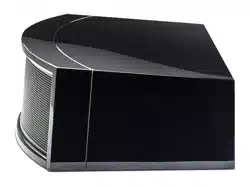Loading ...
Loading ...
Loading ...

13
played very loud, it had poor bass performance, it
presented a difficult load that some amplifiers did
not like, its dispersion was very directional and its
power handling was limited to around 70 watts.
As a result, many people continued to use box
speakers with cones.
In the early 1960’s Arthur Janszen joined
forces with the KLH loudspeaker company,
and together they introduced the KLH 9. Due
to the large size of the KLH 9, it did not have
as many sonic limitations as the Quad. The
KLH 9 could play markedly louder and lower
in frequency than the Quad ESL. Thus a rivalry
was born.
Janszen continued to develop electrostatic designs.
He was instrumental in the design of the Koss
Model One, the Acoustech and the Dennesen
speakers. Roger West, the chief designer of the
Janszen Corporation, became the president of
Sound Lab. When Janszen Corporation was sold,
the RTR loudspeaker company bought half of
the production tooling. This tooling was used to
make the electrostatic panels for the Servostatic,
a hybrid electrostatic system that was Infinity’s first
speaker product. Other companies soon followed;
each with their own unique applications of
the technology. These include Acoustat,
Audiostatic, Beveridge, Dayton Wright, Sound
Lab and Stax, to name a few.
Electrostatic speakers have progressed and
prospered because they actually do what Peter
Walker claimed they would. The limitations and
problems experienced in the past were not inherent
to the electrostatic concept. They were related to
the applications of these concepts.
Today, these limitations have been resolved.
Advancements in materials due to the U.S. space
program give designers the ability to harness the
superiority of the electrostatic principle. Today’s
electrostats use advanced insulation techniques or
provide protection circuitry. The poor dispersion
properties of early models have been addressed
by using delay lines, acoustical lenses, multiple
panel arrays or, as in our own products, by
curving the diaphragm. Power handling and
sensitivity have also been increased.
These developments allow the consumer the
opportunity to own the highest performance
loudspeaker products ever built. It’s too bad Rice
and Kellogg were never able to see just how far
the technology would be taken.
frequently asked questIons
How do I clean my speakers?
Use a dust free cloth or a soft brush to remove the
dust from your speakers. For the wood surfaces it is
acceptable to slightly dampen the cloth. Do not spray
any kind of cleaning agent on or in close proximity to
the electrostatic element. Avoid the use of ammonia
based products or silicone oil on the wood parts.
How do I vacuum my MartinLogan speakers?
Vacuuming will be most effective if the speakers
have been unplugged for six hours to twelve
hours (or overnight). You need not worry about
the vacuum pressure damaging the “delicate”
membrane. It is extraordinarily durable. Dirt and
dust may be vacuumed off. Use an open hose
with your finger tips at the opening acting as a
soft bumper to prevent the hose from scratching
the coating of the panel. When vacuuming or
blowing off your panels do so to both sides, but
focus the majority of your attention on the front of
the panels.
Loading ...
Loading ...
Loading ...
